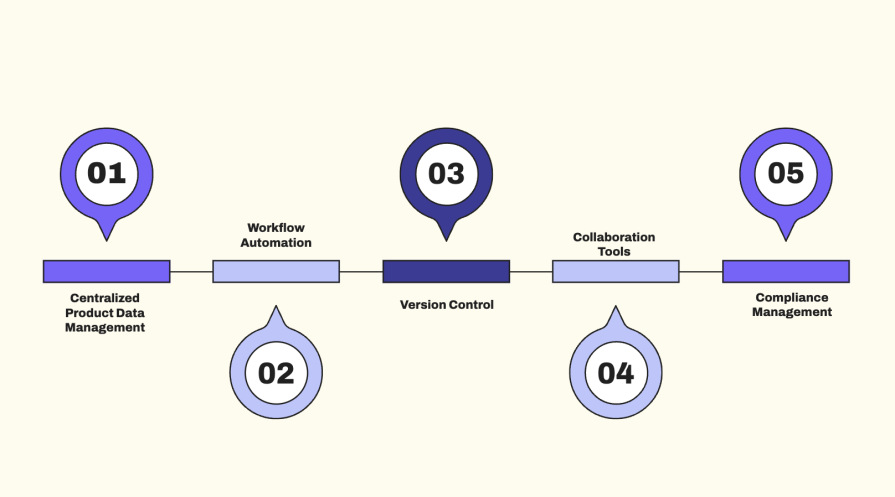PLM software isn’t just a repository for product data; it’s the backbone of modern product development. The right PLM solution can bridge gaps across teams, reduce inefficiencies, and accelerate time-to-market.

However, with so many options available, how do you select the best one for your organization? Choosing the wrong PLM software can lead to unnecessary complexity, frustration, and even lost opportunities.
This guide breaks down what PLM software is, its benefits, key features to prioritize, and actionable steps to choose the right solution for your needs. Let’s dive in.
At its core, product lifecycle management (PLM) software is a tool designed to manage every aspect of a product’s lifecycle, from ideation and design to manufacturing, service, and retirement. It provides a centralized platform where all stakeholders can access consistent, up-to-date product information.
When it comes to PLM software, key functionalities include:

Understanding how PLM software differs from similar systems can help you clarify its role. The following list breaks it down alongside PDM and ERP:
Think of PDM as the toolbox, ERP as the operations ledger, and PLM as the blueprint that ties it all together.
PLM software offers transformative benefits that go beyond data management, it’s a driver of efficiency, collaboration, and innovation. If you’re looking for a reason to invest, PLM software contributes to:
Not all PLM solutions are created equal, and the right choice depends on your organization’s specific needs. Here are the essential features to prioritize:
The following chart breaks down the most popular PLM software solutions and compares their strengths, industries, and pricing:
| PLM software | Strengths | Industries | Pricing |
| Siemens Teamcenter | Comprehensive data management, lifecycle collaboration, and scalability | Automotive, aerospace, consumer goods | Enterprise-level; ideal for large organizations |
| PTC Windchill | Strong CAD integration, IoT support, and advanced analytics | Manufacturing, electronics, life sciences | Modular pricing; scalable for mid-size to large enterprises |
| Autodesk Fusion Lifecycle | Cloud-based collaboration and user-friendly interface | SMEs in manufacturing and design | Subscription-based, affordable for small to mid-sized businesses |
| Oracle Agile PLM | Robust compliance management and analytics tools | Pharmaceuticals, food and beverage, technology | Tailored for enterprise needs |
| Aras Innovator | Open-source flexibility and customization | Versatile for various sectors | Free core platform with paid enterprise features |
Selecting a PLM system is a strategic decision that requires careful consideration. Here’s how to approach it:
Start by identifying your organization’s pain points and objectives. Do you need better version control, enhanced collaboration, or advanced compliance tools? Document these priorities to guide your search.
Your team will use the system daily. Engage engineers, designers, supply chain managers, and other stakeholders early in the process to gather their input.
Choose a vendor with a strong reputation, reliable support, and a proven track record in your industry. Assess their training and implementation offerings to ensure a smooth transition.
Factor in not just the initial purchase price, but also ongoing costs like training, upgrades, and maintenance. Compare these against the expected ROI.
Request demos or trial access to evaluate usability and compatibility. Involve end-users to ensure the system meets their needs and workflows.
Even the best PLM software fail without a solid implementation plan. Assign a project manager, set clear milestones, and prioritize training to ensure user adoption.
Before implementing a PLM software, read through these FAQs to make sure it is a good fit for your product team:

Choosing the right PLM software is about more than finding a tool, it’s about enabling your team to work smarter, innovate faster, and deliver better products. By understanding your organization’s needs, evaluating features, and planning for implementation, you can select a solution that drives success.
Investing in the right PLM software isn’t just a decision for today, it’s a commitment to the future of your product development processes. With the right system in place, you’ll unlock new efficiencies, improve collaboration, and stay ahead of your competition. Good luck implementing!
Featured image source: IconScout

LogRocket identifies friction points in the user experience so you can make informed decisions about product and design changes that must happen to hit your goals.
With LogRocket, you can understand the scope of the issues affecting your product and prioritize the changes that need to be made. LogRocket simplifies workflows by allowing Engineering, Product, UX, and Design teams to work from the same data as you, eliminating any confusion about what needs to be done.
Get your teams on the same page — try LogRocket today.

A practical framework for PMs to use AI in ideation without sacrificing judgment, strategy, or decision quality.

A practical five minute revenue estimation method to help product managers compare ideas, drop low impact features, and prioritize smarter.

A practical guide for PMs who want to stop being bottlenecks, delegate smarter, and lead teams effectively with a clear ownership framework.

Stop letting unreliable data block features. Treat data as inventory to track quality, ownership, and ship with confidence.